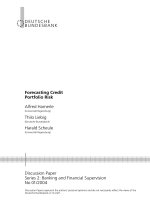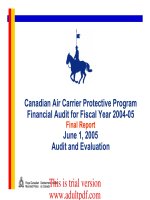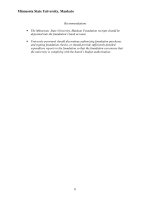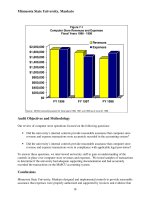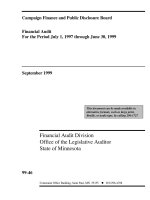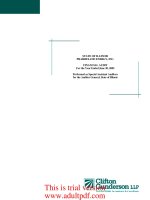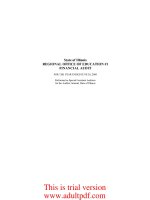Financial information for managemetn paper 1 2 2005 quest2
Bạn đang xem bản rút gọn của tài liệu. Xem và tải ngay bản đầy đủ của tài liệu tại đây (117.14 KB, 14 trang )
PART 1
FRIDAY 10 JUNE 2005
QUESTION PAPER
Time allowed 3 hours
This paper is divided into two sections
Section A
ALL 25 questions are compulsory and MUST be
answered
Section B
ALL FIVE questions are compulsory and MUST be
answered
Formulae Sheet is on page 14
Do not open this paper until instructed by the supervisor
This question paper must not be removed from the examination
hall
The Association of Chartered Certified Accountants
Paper 1.2
Financial
Information for
Management
Section A – ALL 25 questions are compulsory and MUST be attempted
Please use the Candidate Registration Sheet provided to indicate your chosen answer to each multiple choice question.
Each question within this section is worth 2 marks.
1
Four lines representing expected costs and revenue have been drawn on a break-even chart:
A
£
B
C
D
Output
0
Which line represents total variable cost?
2
A
Line A
B
Line B
C
Line C
D
Line D
Four lines have been labelled as J, K, L and M at different levels of output on the following profit-volume chart:
£
M
Output
0
L
J
K
Which line represents the total contribution at the corresponding level of output?
A
Line J
B
Line K
C
Line L
D
Line M
2
3
A manufacturing company has four types of cost (identified as T1, T2 , T3 and T4).
The total cost for each type at two different production levels is:
Cost type
T1
T2
T3
T4
Total cost for
125 units
£
1,000
1,750
2,475
3,225
Total cost for
180 units
£
1,260
2,520
2,826
4,644
Which two cost types would be classified as being semi-variable?
4
A
T1 and T3
B
T1 and T4
C
T2 and T3
D
T2 and T4
A company manufactures and sells a single product. The following data relate to a weekly output of 2,880 units:
£ per unit
Selling price
Less costs:
Variable production
Other variable
Fixed
£ per unit
80
30
10
25
—–
(65)
—–
15
—–
Profit
What is the weekly break-even point (in units)?
5
A
1,900
B
1,440
C
1,800
D
4,800
An organisation manufactures a single product which is sold for £60 per unit. The organisation’s total monthly fixed
costs are £54,000 and it has a contribution to sales ratio of 40%. This month it plans to manufacture and sell
4,000 units.
What is the organisation’s margin of safety this month (in units)?
A
1,500
B
1,750
C
2,250
D
2,500
3
[P.T.O.
6
An organisation is using linear regression analysis to establish an equation that shows a relationship between
advertising expenditure and sales. It will then use the equation to predict sales for given levels of advertising
expenditure. Data for the last five periods are as follows:
Period
number
Advertising
expenditure
£000
17
19
24
22
18
1
2
3
4
5
Sales
£000
108
116
141
123
112
What are the values of ‘Σx’, ‘Σy’ and ‘n’ that need to be inserted into the appropriate formula?
7
8
9
A
Σx
£600,000
Σy
£100,000
n
5
B
£100,000
£600,000
5
C
£600,000
£100,000
10
D
£100,000
£600,000
10
Which of the following correlation coefficients indicates the weakest relationship between two variables?
A
+ 1·0
B
+ 0·4
C
– 0·6
D
– 1·0
Which of the following statements is NOT correct?
A
Bar codes are only used by retailing organisations.
B
Optical mark recognition is used by some educational organisations to mark multiple choice examination
questions.
C
Magnetic ink character recognition is used in the banking industry.
D
The keyboard is an input device used by many different types of organisation.
Which of the following statements are correct?
(i)
Strategic information is mainly used by senior management in an organisation.
(ii) Productivity measurements are examples of tactical information.
(iii) Operational information is required frequently by its main users.
A
(i) and (ii) only
B
(i) and (iii) only
C
(ii) and (iii) only
D
(i), (ii) and (iii)
4
10 A company manufactures two products P1 and P2 in a factory divided into two cost centres, X and Y. The following
budgeted data are available:
Cost centre
Allocated and apportioned fixed
overhead costs
Direct labour hours per unit:
Product P1
Product P2
X
Y
£88,000
£96,000
3·0
2·5
1·0
2·0
Budgeted output is 8,000 units of each product. Fixed overhead costs are absorbed on a direct labour hour basis.
What is the budgeted fixed overhead cost per unit for Product P2?
A
£10
B
£11
C
£12
D
£13
11 A manufacturing company uses a machine hour rate to absorb production overheads, which were budgeted to be
£130,500 for 9,000 machine hours. Actual overheads incurred were £128,480 and 8,800 machine hours were
recorded.
What was the total under absorption of production overheads?
A
£880
B
£900
C
£2,020
D
£2,900
12 Which of the following would NOT be classified as a service cost centre in a manufacturing company?
A
Product inspection department
B
Materials handling department
C
Maintenance department
D
Stores
5
[P.T.O.
13 The following data relate to material QQ2 for last month:
Opening stock
Purchases:
3rd
17th
Issues:
12th
19th
300kg
valued at
£
2,700
500kg
400kg
for
for
5,500
4,200
600kg
300kg
Using the LIFO valuation method, what was the value of the closing stock for QQ2 last month?
A
£2,700
B
£2,850
C
£3,150
D
£3,300
14 A company operates a job costing system. Job number 605 requires £300 of direct materials and £400 of direct
labour. Direct labour is paid at the rate of £8 per hour. Production overheads are absorbed at a rate of £26 per direct
labour hour and non-production overheads are absorbed at a rate of 120% of prime cost.
What is the total cost of job number 605?
A
£2,000
B
£2,400
C
£2,840
D
£4,400
The following information relates to questions 15 and 16:
A company operates a process costing system using the first in first out (FIFO) method of valuation. No losses occur in the
process.
The following data relate to last month:
Opening work in progress
Completed during the month
Closing work in progress
Units
100
900
150
Degree of completion
60%
48%
The cost per equivalent unit of production for last month was £12.
15 What was the value of the closing work in progress?
A
£816
B
£864
C
£936
D
£1,800
6
Value
£680
16 What was the total value of the units completed last month?
A
£10,080
B
£10,320
C
£10,760
D
£11,000
17 A company’s budgeted sales for last month were 10,000 units with a standard selling price of £20 per unit and a
contribution to sales ratio of 40%. Last month actual sales of 10,500 units with total revenue of £204,750 were
achieved.
What were the sales price and sales volume contribution variances?
A
Sales price variance (£)
5,250 adverse
Sales volume contribution variance (£)
4,000 favourable
B
5,250 adverse
4,000 adverse
C
5,000 adverse
4,000 favourable
D
5,000 adverse
4,000 adverse
18 A company operates a standard absorption costing system. The standard fixed production overhead rate is £15 per
hour.
The following data relate to last month:
Actual hours worked
Budgeted hours
Standard hours for actual production
5,500
5,000
4,800
What was the fixed production overhead capacity variance?
A
£7,500 adverse
B
£7,500 favourable
C
£10,500 adverse
D
£10,500 favourable
19 A contract is under consideration which requires 600 labour hours to complete. There are 350 hours of spare labour
capacity. The remaining hours for the contract can be found either by weekend overtime working paid at double the
normal rate of pay or by diverting labour from the manufacture of product QZ. If the contract is undertaken and labour
is diverted, then sales of product QZ will be lost. Product QZ takes three labour hours per unit to manufacture and
makes a contribution of £12 per unit. The normal rate of pay for labour is £9 per hour.
What is the total relevant cost of labour for the contract?
A
£1,000
B
£2,250
C
£3,250
D
£4,500
7
[P.T.O.
20 A company purchased a machine several years ago for £50,000. Its written down value is now £10,000. The
machine is no longer used on normal production work and it could be sold now for £8,000.
A one-off contract is being considered which would make use of this machine for six months.
machine would be sold for £5,000.
After this time the
What is the relevant cost of the machine to the contract?
A
£2,000
B
£3,000
C
£5,000
D
£10,000
21 A company, which manufactures four components (A, B, C and D) using the same machinery, aims to maximise
profit. The following information is available:
Component
Variable production cost per unit (£)
Purchase cost per unit from
an outside supplier (£)
Machine hours per unit to manufacture
A
B
C
D
60
64
70
68
100
4
120
7
130
5
110
6
As it has insufficient machine hours available to manufacture all the components required, the company will need to
buy some units of one component from the outside supplier.
Which component should be purchased from the outside supplier?
A
Component A
B
Component B
C
Component C
D
Component D
8
22 A company has three branches (X, Y and Z) to which the following budgeted information relates:
Sales
Contribution
Less: Fixed costs
Profit/(loss)
Branch
X
£000
200
——
60
(35)
——
25
——
Branch
Y
£000
200
——
50
(35)
——
15
——
Branch
Z
£000
200
——
20
(30)
——
(10)
——
Total
£000
600
——
130
(100)
——
30
——
60% of the total fixed costs are general overheads. General overheads are apportioned to the branches on the basis
of sales value. The other fixed overheads are specific to each branch and are avoidable if a branch closes down.
If branch Z is closed down and the sales of the other two branches remained the same, what would be the revised
budgeted profit for the company?
A
£10,000
B
£20,000
C
£40,000
D
£50,000
23 Reginald is the manager of production department M in a factory which has ten other production departments. He
receives monthly information that compares planned and actual expenditure for department M. After department M,
all production goes into other factory departments to be completed prior to being despatched to customers. Decisions
involving capital expenditure in department M are not taken by Reginald.
Which of the following describes Reginald’s role in department M?
A
A cost centre manager
B
An investment centre manager
C
A profit centre manager
D
A revenue centre manager
9
[P.T.O.
The following information relates to questions 24 and 25
A company manufactures and sells two products (X and Y) which have contributions per unit of £8 and £20 respectively.
The company aims to maximise profit. Two materials (G and H) are used in the manufacture of each product. Each
material is in short supply – 1,000 kg of G and 1,800 kg of H are available next period. The company holds no stocks
and it can sell all the units produced.
The management accountant has drawn the following graph accurately showing the constraints for materials G and H.
Product Y
(units)
Material G
100
90
Material H
Product X
(units)
0
125
150
24 What is the amount (in kg) of material G and material H used in each unit of product Y?
A
Material G
10
Material H
20
B
10
10
C
20
20
D
20
10
25 What is the optimal mix of production (in units) for the next period?
A
Product X
0
Product Y
90
B
50
60
C
60
50
D
125
0
(50 marks)
10
Section B – ALL FIVE questions are compulsory and MUST be attempted
1
Saphir Ltd operates a process which creates two joint products, X and Y, in the ratio of 7 : 5 by weight. No stocks
of work in progress are held in the process and there is a normal process loss equal to 5% of input. Losses have a
realisable value of £2 per kg.
The following information relates to the process for last month:
10,000 kg of raw materials with a total cost of £18,750 were input into the process and the direct labour costs were
£50,000. Overheads were absorbed at a rate of 140% of direct labour. The actual loss was 400 kg.
Joint production costs are apportioned to products using the sales value method. Selling prices of the joint products
are:
Product
X
Y
Selling price per unit
£25·00
£37·50
Required:
(a) Prepare the process account for last month in which both the output weight and value for each of the joint
products are shown.
(8 marks)
(b) Explain briefly the characteristics of a by-product.
(2 marks)
(10 marks)
2
Murgatroyd Ltd, which manufactures a single product, uses standard absorption costing. A summary of the standard
product cost is as follows:
Direct materials
Direct labour
Fixed overheads
£ per unit
15
20
12
Budgeted and actual production for last month were 10,000 units and 9,000 units respectively. The actual costs
incurred were:
Direct materials
Direct labour
Fixed overheads
£
138,000
178,000
103,000
Required:
(a) Prepare a statement that reconciles the standard cost of actual production with its actual cost for last month
and highlights the total variance for each of the three elements of cost.
(4 marks)
Last month 24,000 litres of direct material were purchased and used by the company. The standard allows for
2·5 litres of the material, at £6 per litre, to be used in each unit of product.
(b) Provide an appropriate breakdown of the total direct materials cost variance included in your statement
in (a).
(3 marks)
(c) Explain who in the company should be involved in setting:
(i)
the standard price; and
(ii) the standard quantity for direct materials.
(3 marks)
(10 marks)
11
[P.T.O.
3
Jane plc purchases its requirements for component RB at a price of £80 per unit. Its annual usage of component
RB is 8,760 units. The annual holding cost of one unit of component RB is 5% of its purchase price and the cost of
placing an order is £12·50.
Required:
(a) Calculate the economic order quantity (to the nearest unit) for component RB.
(2 marks)
(b) Assuming that usage of component RB is constant throughout the year (365 days) and that the lead time
from placing an order to its receipt is 21 days, calculate the stock level (in units) at which an order should
be placed.
(2 marks)
(c) (i)
Explain the terms ‘stockout’ and ‘buffer stock’.
(ii) Briefly describe the circumstances in which Jane plc should consider having a buffer stock of component
RB.
(4 marks)
(8 marks)
4
Archibald Ltd manufactures and sells one product. Its budgeted profit statement for the first month of trading is as
follows:
£
Sales (1,200 units at £180 per unit)
Less: Cost of sales:
Less: Production (1,800 units at £100 per unit)
Less: Less Closing stock (600 units at £100 per unit)
£
216,000
180,000
(60,000)
————
(120,000 )
————
96,000
(41,000 )
————
55,000
————
Gross profit
Less Fixed selling and distribution costs
Net profit
The budget was prepared using absorption costing principles. If budgeted production in the first month had been
2,000 units then the total production cost would have been £188,000.
Required:
(a) Using the high-low method, calculate:
(i)
the variable production cost per unit; and
(ii) the total monthly fixed production cost.
(4 marks)
(b) If the budget for the first month of trading had been prepared using marginal costing principles, calculate:
(i)
the total contribution; and
(ii) the net profit.
(4 marks)
(c) Explain clearly the circumstances in which the monthly profit or loss would be the same using absorption or
marginal costing principles.
(2 marks)
(10 marks)
12
5
Ella Ltd recently started to manufacture and sell product DG. The variable cost of product DG is £4 per unit and the
total weekly fixed costs are £18,000.
The company has set the initial selling price of product DG by adding a mark up of 40% to its total unit cost. It has
assumed that production and sales will be 3,000 units per week.
The company holds no stocks of product DG.
Required:
(a) Calculate for product DG:
(i) the initial selling price per unit; and
(ii) the resultant weekly profit.
(3 marks)
The management accountant has established that a linear relationship beween the unit selling price (P in £) and the
weekly demand (Q in units) for product DG is given by:
P = 20 – 0·002Q
The marginal revenue (MR in £ per unit) is related to weekly demand (Q in units) by the equation:
MR = 20 – 0·004Q
(b) Calculate the selling price per unit for product DG that should be set in order to maximise weekly profit.
(7 marks)
(c) Distinguish briefly between penetration and skimming pricing policies when launching a new product.
(2 marks)
(12 marks)
13
[P.T.O.
Formulae Sheet
End of Question Paper
14
